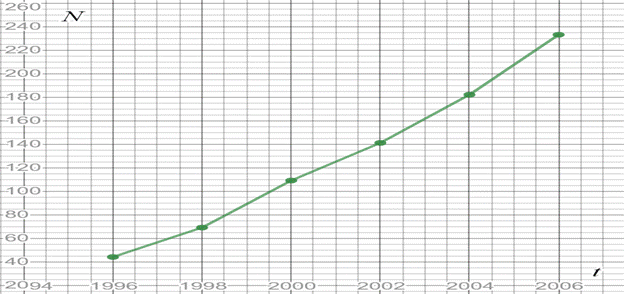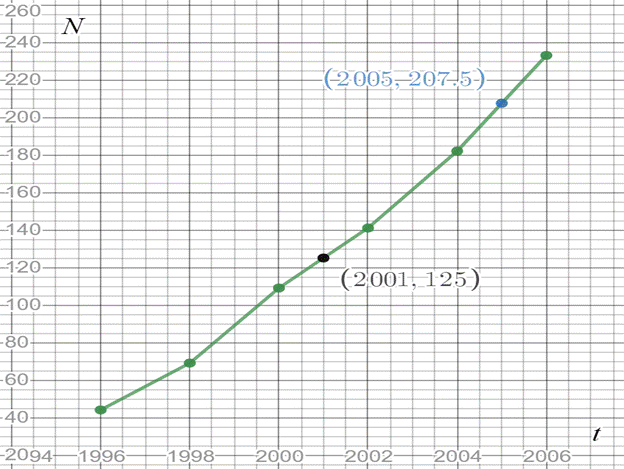
a.
To graph: The number N
| t | 1996 | 1998 | 2000 | 2002 | 2004 | 2006 |
| N | 44 | 69 | 109 | 141 | 182 | 233 |
a.
Explanation of Solution
Given information:
The number N
| t | 1996 | 1998 | 2000 | 2002 | 2004 | 2006 |
| N | 44 | 69 | 109 | 141 | 182 | 233 |
Graph:
The graph of N vs t can be drawn by using t as x-axis and N as y-axis. The obtained graphs is as like this,

Interpretation:
The obtained graph shows that the number of US cellular phone subscribers are continuously increasing from 1996 to 2006.
b.
To calculate: The estimation of the number of cell-phone subscribers at midyear in 2001 and 2005, Using the given graph.

b.
Answer to Problem 21E
The estimated numbers of cell-phone subscribers at the midyear 2001 are 125 millions and at the midyear 2005 are 207.5 millions.
Explanation of Solution
Given information:
The number N
| t | 1996 | 1998 | 2000 | 2002 | 2004 | 2006 |
| N | 44 | 69 | 109 | 141 | 182 | 233 |
Calculation:
Consider the given graph, the year 2001 lies in between 2000 and 2002 on the x-axis. Now, take the corresponding value of y with respect to x as 2001, it is find out to be 125 on this graph.
Similarly, the year 2005 lies in between 2004 and 2006 on the x-axis. Now, take the corresponding value of y with respect to x as 2005, it is find out to be 207.5 on this graph.

Therefore, the estimated numbers of cell-phone subscribers at the midyear 2001 are 125 millions and at the midyear 2005 are 207.5 millions.
Chapter 1 Solutions
Single Variable Calculus: Concepts and Contexts, Enhanced Edition
- = 5 37 A 4 8 0.5 06 9arrow_forwardConsider the following system of equations, Ax=b : x+2y+3z - w = 2 2x4z2w = 3 -x+6y+17z7w = 0 -9x-2y+13z7w = -14 a. Find the solution to the system. Write it as a parametric equation. You can use a computer to do the row reduction. b. What is a geometric description of the solution? Explain how you know. c. Write the solution in vector form? d. What is the solution to the homogeneous system, Ax=0?arrow_forward2. Find a matrix A with the following qualities a. A is 3 x 3. b. The matrix A is not lower triangular and is not upper triangular. c. At least one value in each row is not a 1, 2,-1, -2, or 0 d. A is invertible.arrow_forward
- Find the exact area inside r=2sin(2\theta ) and outside r=\sqrt(3)arrow_forwardA 20 foot ladder rests on level ground; its head (top) is against a vertical wall. The bottom of the ladder begins by being 12 feet from the wall but begins moving away at the rate of 0.1 feet per second. At what rate is the top of the ladder slipping down the wall? You may use a calculator.arrow_forwardExplain the focus and reasons for establishment of 12.4.1(root test) and 12.4.2(ratio test)arrow_forward
- Use 12.4.2 to determine whether the infinite series on the right side of equation 12.6.5, 12.6.6 and 12.6.7 converges for every real number x.arrow_forwarduse Cauchy Mean-Value Theorem to derive Corollary 12.6.2, and then derive 12.6.3arrow_forwardExplain the focus and reasons for establishment of 12.5.4arrow_forward
 Calculus: Early TranscendentalsCalculusISBN:9781285741550Author:James StewartPublisher:Cengage Learning
Calculus: Early TranscendentalsCalculusISBN:9781285741550Author:James StewartPublisher:Cengage Learning Thomas' Calculus (14th Edition)CalculusISBN:9780134438986Author:Joel R. Hass, Christopher E. Heil, Maurice D. WeirPublisher:PEARSON
Thomas' Calculus (14th Edition)CalculusISBN:9780134438986Author:Joel R. Hass, Christopher E. Heil, Maurice D. WeirPublisher:PEARSON Calculus: Early Transcendentals (3rd Edition)CalculusISBN:9780134763644Author:William L. Briggs, Lyle Cochran, Bernard Gillett, Eric SchulzPublisher:PEARSON
Calculus: Early Transcendentals (3rd Edition)CalculusISBN:9780134763644Author:William L. Briggs, Lyle Cochran, Bernard Gillett, Eric SchulzPublisher:PEARSON Calculus: Early TranscendentalsCalculusISBN:9781319050740Author:Jon Rogawski, Colin Adams, Robert FranzosaPublisher:W. H. Freeman
Calculus: Early TranscendentalsCalculusISBN:9781319050740Author:Jon Rogawski, Colin Adams, Robert FranzosaPublisher:W. H. Freeman
 Calculus: Early Transcendental FunctionsCalculusISBN:9781337552516Author:Ron Larson, Bruce H. EdwardsPublisher:Cengage Learning
Calculus: Early Transcendental FunctionsCalculusISBN:9781337552516Author:Ron Larson, Bruce H. EdwardsPublisher:Cengage Learning





